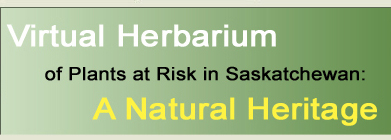
|

|

|

|

|

|

|
|
|
|
|
|
| Lotus unifoliolatus var. unifoliolatus (Hook.) Benth. | Species Image Gallery (opens in a new window) |
||||||||
| TAXONOMY | |||||||||
| Family: | Fabaceae | ||||||||
| Genus: | Lotus | ||||||||
| Species Synonyms: | Hosackia americana (Nutt.) Piper Lotus americanus (Nutt.) Bisch., non Vell. Lotus purshianus F.E. & E.G. Clem. Lotus purshianus var. glaber (Nutt.) Munz Lotus sericeus Pursh, non Moench |
||||||||
| Common Names: | Spanish clover prairie trefoil American bird’s-foot trefoil |
||||||||
| DISTRIBUTION | |||||||||
| Canada: | southwestern British Columbia, southeastern Saskatchewan – southern Manitoba | ||||||||
| Saskatchewan: | southeastern Saskatchewan; Souris River Valley, Antler River Valley | ||||||||
| Ecoregion: | Mixed Grassland, Moist Mixed Grassland, Aspen Parkland | ||||||||
| HABITAT | |||||||||
| Saskatchewan: | slough bottoms, streamlet margins, and seepy slopes | ||||||||
| Associated Species: | big bluestem, crane’s bill, foxtail, goldenrod, little blue stem, sedges, short-awn meadow foxtail, slenderleaf collomia, smooth brome | ||||||||
| RARITY STATUS | |||||||||
| Provincial
Status According to Harms (2003): |
Threatened |
||||||||
| Nature Conservancy Status: | G5T5 S2 |
||||||||
| Saskatchewan
Species at Risk Status: |
None |
||||||||
| COSEWIC Status: | None |
||||||||
| Spanish clover is threatened in Saskatchewan because it is rare or uncommon. This species is only somewhat regionally restricted but local population sizes vary. Immediate or probable threats have been identified for this species. | |||||||||
| SPECIES DESCRIPTION | |||||||||
| Roots: | taproot slender | ||||||||
| Stems: | annual, herbaceous, erect, 20 – 80 cm tall, branched, hairless to densely hairy | ||||||||
| Stipules: | gland-like, blackish | ||||||||
| Leaves: | alternate, subsessile | ||||||||
| Leaflets: | 3, terminal leaflet stalked, 1 – 3 cm long, to 1.5 cm broad, elliptic to oval, hairy | ||||||||
| Inflorescence: | flower solitary, bract leaf-like; inflorescence stalk solitary in upper axils, 1 – 2 cm long | ||||||||
| Flowers: | sepal tube 1.5 – 2 mm long, bell-shaped, teeth mostly more than 2x as long as tube, long hairy; petals white with pink veins, rarely yellowish-white; banner 5 – 7 mm long; wings and keel 4 – 6 mm long | ||||||||
| Fruits: | legume 2 – 4 cm long, oblong, slightly constricted between the seeds, hairless; seeds olive to light brown, often mottled | ||||||||
| |||||||||